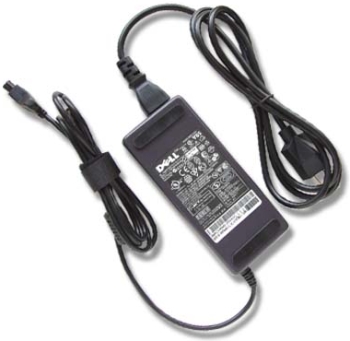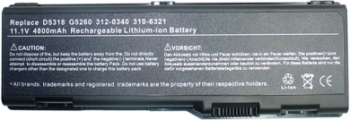You plug your laptop in the wall outlet and turn it on and - nothing. One of the most frequent causes of a totally dead laptop is a defective power adapter. In this article you learn how to determine if your laptop's power adapter is defective.
A laptop power adapter consists of an AC line cord plugged into a power inverter with a DC line coming out the other side that plugs into the power port on the laptop. Most people refer to the power inverter as the "brick". I usually call it the "anchor" because when I move it, it feels like I'm dragging an anchor.
The function of the power adapter is to convert AC power from a wall outlet into DC power for the laptop's circuitry. Because it takes the negative side of the alternating current sign wave and flips it over to be positive, it's sometimes called a power inverter. It also reduces the voltage level and cleans up the signal.
In a desktop computer the power inverter is inside the computer's case. But because the power inverter generates considerable heat, and the designers don't want that heat inside the laptop case, a laptop uses the power brick configuration.
Laptop Power Adapter Troubleshooting
Now, I've been troubleshooting electronics for a long long time so I can tell you almost all problems end up being something stupid. For example at my house some of the AC outlets are switched by a wall switch. This is so that you can plug a lamp in them. Now if the switch was turned off and someone had their laptop plugged into it for a few hours, their laptop battery would totally discharge, their laptop shutdown, and they wouldn't have a clue as to why. The moral of this story is - always check the obvious stuff first.
1. Make sure that you're getting AC power from the wall outlet.
2. Make sure the cable going into the adapter is secure.
3. Make sure the cable coming out of the adapter is securely plugged into the laptop.
4. Is the light on the power supply brick lit?
5. Lightly wiggle the plug where it plugs into the laptop. Many people, when they carry
a laptop leave the adapter plugged into the laptop, causing the connector to break inside the laptop.
One side of the brick has the adapter specifications printed on it. It usually lists the required input voltage as being between 100-240V. This is so you can use the adapter in other countries that use different voltage than the 110V used in the U.S. It also indicates the polarity of the DC plug. The outside of the plug is usually negative and the inside positive.
With the adapter plugged into the wall outlet, you can use a multimeter to check the output of the adapter. With the multimeter set to the appropriate range, put the positive (red) probe in the center hole of the plug, and touch the negative (black) probe to the outside of the plug. Do not let the metal of the two probes touch while connected to the plug.
Compare the output voltage of the adapter to the specification on the brick. For example the brick might specify 19V and 3.16A (19 volts at 3.16 amps). Now since the multimeter isn't drawing anywhere near 3.16 amps, the output voltage of the adapter should be higher than 19 volts.
Also compare that output specification of the adapter with the power specification of your laptop. Some power adapters are interchangeable and you or some else may have inadvertently plugged in the wrong adapter.
If you do have another power adapter with the same plug with the same polarity on the and the same rating, you can swap them out to determine if the adapter is the problem. If you have determined that the power adapter is defective, you can purchase a new power adapter with the same specifications as the defective one.
If you have determined that the power adapter is good, it's time to suspect the laptop's battery.
Laptop Battery Troubleshooting
Most modern laptops use Lithium Ion (li-ion) batteries. Lithium Ion is a wonderful technology, allowing you to use your laptop disconnected from the power source for many hours before needing to recharge it. But Lithium Ion batteries don't recover fully after setting totally discharged for a long period of time. They can also be damaged by using a laptop in below freezing temperatures without letting the battery warm up first, or using a laptop in temperatures near 100 degrees F.
Lithium Ion batteries must be manufactured in an environment that permits absolutely no impurities. If the battery has internal contaminants it will run hot, considerably shortening its life expectancy. Lithium Ion batteries have a limited number of charge-discharge cycles, somewhere between 300 and 500 cycles before their life is over. In addition the charge capacity decreases over time. Over time they will lose their ability to hold a charge.
Fortunately it's very easy to determine if a bad battery is causing the problem. Just remove the battery from the laptop and see if the laptop runs from the power adapter alone. If the laptop runs properly with the adapter alone, first check for corroded contacts at the batteries connectors.
Similar to power adapters, batteries have their specifications printed on one side. When fully charged the battery should have the voltage indicated when providing the power indicated. If you have a known good identical battery with the same specifications and the same physical configuration and connector, you can substitute it for the suspected bad battery.
To find a replacement laptop battery look for one for your computers brand name and model number with the same electrical specifications. On the internet you can find really cheap replacement batteries. Remember what I said about impurities during the manufacturing process? Guess who buys those rejects?
Laptop Doesn't Run From Power Adapter Alone
If you have determined that the power adapter and battery are good, but the laptop is still dead, then it's likely that laptop’s internal electronics have failed. Agian, always check the obvious stuff first.
1. Does the laptop have an external brightness control that's turned all the way down?
2. Try connecting an external LCD display.
2. Remove all removable devices from the laptop's ports.
3. Most laptops give you access to the memory chips. Try removing them one at a time.
4. Some laptops let you remove other devices like removable hard drives.
If none of this works, it's time to disassemble, or to bring the laptop to someone who can disassemble it to take a look inside. However, with the cost and time considerations involved in taking the laptop to a repair shop, it might be cheaper and quicker to buy a new one.

Learn more at amazon.com
More Windows Troubleshooting Articles:
• Troubleshoot Windows XP with Free Upgrade Advisor
• PC Troubleshooting - Symptoms of a Bad CPU
• Free Tool to Recover Files From Damaged Disc
• How to Fix logoncli.dll Error
• Fix CD Writer Buffer Underrun Errors
• How to Find Windows 7 Product Key
• Can't Unistall A Program, Now What?
• Video - Dell Laptop Motherboard Replacement Tutorial
• Fix DNS Server Not Responding on Windows 7
• How to Fix Extensible Storage Engine Errors


